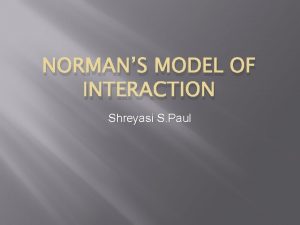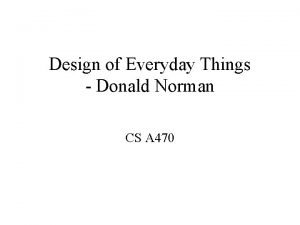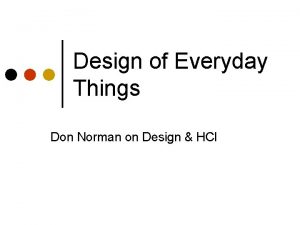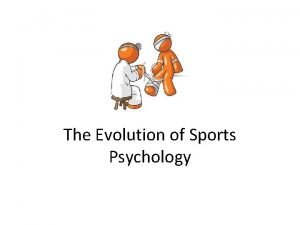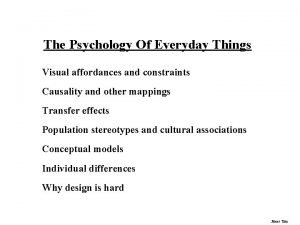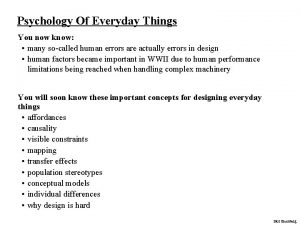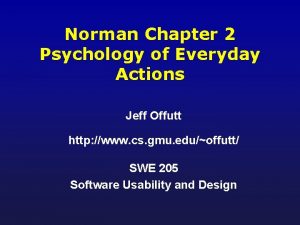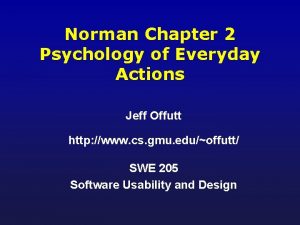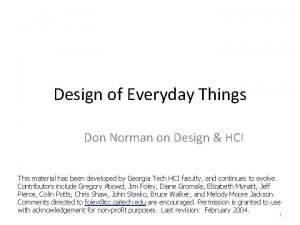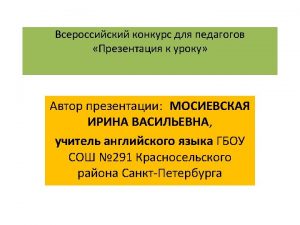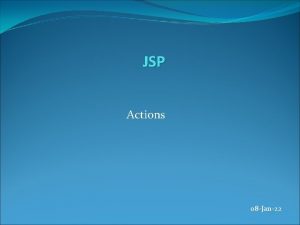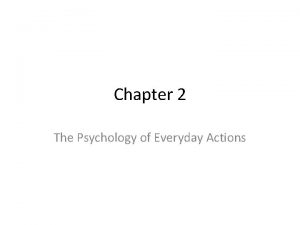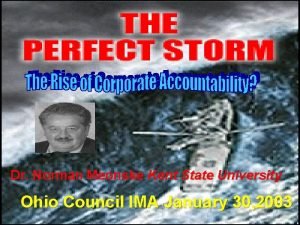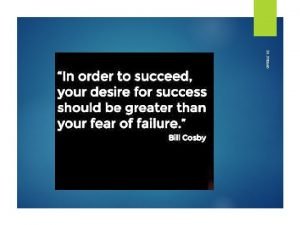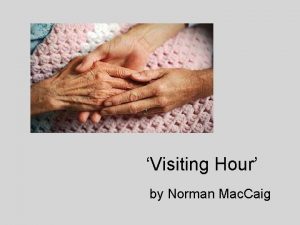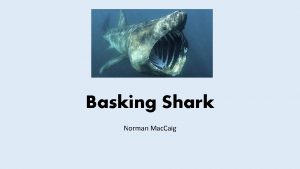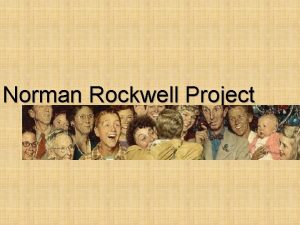The psychology of everyday actions Don Norman CS


































- Slides: 34

The psychology of everyday actions – Don Norman CS 420/620 – Human Computer Interaction Based on slides initially prepared by Majed Al Zayer (former course instructor) University of Nevada, Reno Fall’ 19 1

Agenda • The two gulfs of human-computer interaction • The seven stages of action • Human cognition and emotion (the three levels of processing) • The seven stages of action and the three levels of processing • Stages of action vs. elements of design 2

Agenda • The two gulfs of human-computer interaction • The seven stages of action • Human cognition and emotion (the three levels of processing) • The seven stages of action and the three levels of processing • Stages of action vs. elements of design 3

What happened? How do I work this? Is this what I wanted? What can I do? Gulf of evaluation Gulf of execution Goal World 4

The Gulf of Execution: when people try to figure out how to use a device (item, interface) The Gulf of Evaluation: where they try to figure out what state the device is in and whether their actions got them to their goal 5

As designer, your mission is to “help people bridge the two gulfs” 6

Agenda • The two gulfs of human-computer interaction • The seven stages of action • Human cognition and emotion (the three levels of processing) • The seven stages of action and the three levels of processing • Stages of action vs. elements of design 7

Plan Compare Specify Interpret Perform Perceive Gulf of evaluation Gulf of execution Goal World 8

Seven stages of actions: one for goal, three for execution, and three for evaluation 1 Goal (form a goal) 2 Plan (the action) 3 Specify (an action sequence) 4 Perform (the action sequence) 5 Perceive (the state of the world) 6 Interpret (the perception) 7 Compare (the outcome with the goal) 9

Stage #1: Formulate the goal Open the “find in page” search box 10

Stage #2: Plan the action • Use some command(s) to open “find in page” 11

Stage #3: Specify the action • Cntrl + F • Menu -> Find 12

Stage #4: Perform the action Press Ctrl + F 13

14

Stage #5: Perceive the state I see a box on the upper right corner 15

Stage #6: Interpret the state • This is a search box • invoked by the browser • it’s not the address box • It’s enabled 16

Stage #7: Compare the state to the goal … then, it’s the ”find in page” dialog 17

Stages of action: Triggers Event-driven Self-driven Actions performed as a response to an event triggered by the world Actions performed to accomplish a goal 18

Stages of action: Event-driven triggers Plan Compare Specify Interpret Perform Perceive �� World 19 Gulf of evaluation Gulf of execution Goal

Stages of action: Self-driven triggers Plan Compare Specify Interpret Perform Perceive World 20 Gulf of evaluation Gulf of execution �� Goal

Stages of action: Goals and sub-goals Gulf of execution Compare Specify Interpret Perform Perceive Gulf of evaluation Plan Compare Specify Interpret Perform Perceive Gulf of evaluation �� Open “find in page” Gulf of execution �� Find HCI definition World 21

Agenda • The two gulfs of human-computer interaction • The seven stages of action • Human cognition and emotion (the three levels of processing) • The seven stages of action and the three levels of processing • Stages of action vs. elements of design 22

Subconscious and Conscious Systems of Cognition • Subconscious thought § Fast § Automatic § Multiple resources § Controls skilled behavior • Conscious thought • • Slowed Controlled Limited resources Invoked for novel situations: when learning, when in danger, when things go wrong 23

Three Levels of Processing 1 Visceral • The basic level • Quick & subconscious judgements about the environment: good or bad, safe or dangerous • Fast and automatic • About immediate perception 2 Behavioral • Home of learned skills • Actions and analyses are largely subconscious (e. g. , playing a sport) • Actions associated with expectations • Behavioral states are learned 24

Three Levels of Processing 3 Reflective Home of conscious cognition Involves analysis, reasoning and decision making Cognitive, deep, and slow Often happens after events occurred; also, can be about predictions • Highest level of emotions come from this level • • In summary • Visceral and behavioral levels are subconscious & home of basic emotions • The reflective level is where conscious thought and decisionmaking reside, and is home of highest level of emotions • Design must take place at all levels 25

Agenda • The two gulfs of human-computer interaction • The seven stages of action • Human cognition and emotion (the three levels of processing) • The seven stages of action and the three levels of processing • Stages of action vs. elements of design 26

Plan Reflective Compare Specify Behavioral Interpret Perform Visceral Perceive Gulf of evaluation Gulf of execution Goal World 27

Agenda • The two gulfs of human-computer interaction • The seven stages of action • Human cognition and emotion (the three levels of processing) • The seven stages of action and the three levels of processing • Stages of action vs. elements of design 28

Stages of action: So what? What are the alternatives? Is this okay? What can I do? What does it mean? How do I do it? What happened? World Feedback Feedforward What do I want to accomplish? 29

Stages of action: So what? • Task analysis �� How do people perform an action? �� What are the goals/sub-goals? �� What is the ultimate goal? �� Where do people struggle exactly? 30

Stages of action: So what? • Product evaluation �� Are people aware of all alternatives? �� Can they satisfy their goal with at least one of these alternatives? �� Do they know how to do the actions? �� Can they perceive the feedback? �� Can they make sense of this feedback? �� Can they easily know if they accomplished their goal? 31

What are the alternatives? Is this okay? What can I do? What does it mean? How do I do it? What happened? Feedback Feedforward What do I want to accomplish? World 32

• Signifiers • Constraints • Mapping + Conceptual model Discoverability Feedback What are the alternatives? Is this okay? What can I do? What does it mean? How do I do it? What happened? Feedback Feedforward What do I want to accomplish? Feedback that is: • Perceivable • Meaningful • Guiding + Conceptual model World 33

Seven fundamental principles of design • Insights from the seven stages of action lead to the following 7 fundamental principles of design �� Discoverability �� Feedback �� Conceptual model �� Affordances �� Signifiers �� Mappings �� Constraints 34
 7 stages of donald norman's model
7 stages of donald norman's model Don norman constraints
Don norman constraints Don norman affordances
Don norman affordances Norman triplett sports psychology
Norman triplett sports psychology Psychology in everyday life myers
Psychology in everyday life myers Psychology of everyday things
Psychology of everyday things The psychology of everyday things
The psychology of everyday things Greenberg
Greenberg Taking things that don't belong to you
Taking things that don't belong to you Thế nào là hệ số cao nhất
Thế nào là hệ số cao nhất Sơ đồ cơ thể người
Sơ đồ cơ thể người Tư thế ngồi viết
Tư thế ngồi viết đặc điểm cơ thể của người tối cổ
đặc điểm cơ thể của người tối cổ Cái miệng bé xinh thế chỉ nói điều hay thôi
Cái miệng bé xinh thế chỉ nói điều hay thôi Hình ảnh bộ gõ cơ thể búng tay
Hình ảnh bộ gõ cơ thể búng tay Cách giải mật thư tọa độ
Cách giải mật thư tọa độ Tư thế ngồi viết
Tư thế ngồi viết ưu thế lai là gì
ưu thế lai là gì Chó sói
Chó sói Thẻ vin
Thẻ vin Thể thơ truyền thống
Thể thơ truyền thống Các châu lục và đại dương trên thế giới
Các châu lục và đại dương trên thế giới Từ ngữ thể hiện lòng nhân hậu
Từ ngữ thể hiện lòng nhân hậu Diễn thế sinh thái là
Diễn thế sinh thái là Frameset trong html5
Frameset trong html5 V cc
V cc Vẽ hình chiếu vuông góc của vật thể sau
Vẽ hình chiếu vuông góc của vật thể sau Phép trừ bù
Phép trừ bù Hát lên người ơi alleluia
Hát lên người ơi alleluia Hổ sinh sản vào mùa nào
Hổ sinh sản vào mùa nào Lời thề hippocrates
Lời thề hippocrates Tư thế worms-breton
Tư thế worms-breton đại từ thay thế
đại từ thay thế Quá trình desamine hóa có thể tạo ra
Quá trình desamine hóa có thể tạo ra Công của trọng lực
Công của trọng lực
